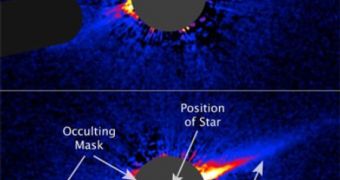Astronomers have just found an unusual blue halo around a distant star that looks like a glowing cosmic needle. This enlarged debris disk could point at hidden planets, since it is a well-known fact that they are leftovers from planet formation processes.
The young star is called HD 15115, observed using NASA's Hubble Space Telescope and the W.M. Keck Observatory in Hawaii may not necessarily have planets around itself but most likely is under the influence of planets orbiting other nearby stars that have long elliptical orbits.
Study leader Paul Kalas of the University of California, Berkeley, thinks one of the stars responsible for the unusual phenomenon could be HIP 12545, a star located only 10 light years away from HD 15115.
This debris disk is thought to be made up of leftover material from planet formation processes, much like our own Kuiper Belt, the region in space beyond the orbit of Neptune where hundred of celestial bodies are gathered, including dwarf planets like Pluto.
HD 15115 has the disk located at about same distance around it as the Kuyper Belt around our own Sun, only that it extends around 10 times further, to at least 550 Astronomical Units (units of length nearly equal to the semi-major axis of Earth's orbit around the Sun).
Dust in the disk is constantly replenished by cosmic collisions between icy and rocky bodies inside it and is distorted by the gravity of nearby planets, the same way Neptune influences objects in the Kuyper Belt.
It is thought that Neptune itself formed not where it is now, but rather between Saturn and Uranus and was later pushed out to the edges of the solar system by the combined gravities of Saturn and Jupiter.
"If such a planetary upheaval were occurring around HD 15115 at the present time, it could explain the highly asymmetric disk," said Kalas. In addition to being greatly distorted, the disk around this star also contains significantly less dust.
"The missing mass is quite interesting," Kalas said. "Perhaps the mechanism which perturbed the disk into its current asymmetric morphology also shaved away a significant fraction of the mass."
So far, one can't tell whether this disk is permanent or it will eventually assume the regular circular shape later in its evolution. "The blue needle presents a host of new challenges for theorists," Kalas said.

 14 DAY TRIAL //
14 DAY TRIAL //